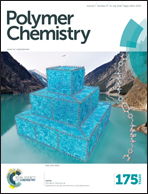Efficient synthesis of narrowly dispersed amphiphilic double-brush copolymers through the polymerization reaction of macromonomer micelle emulsifiers at the oil–water interface†
Abstract
In this study, well-defined amphiphilic double-brush copolymers (DBCs) with narrow molecular weight distributions were efficiently synthesized by the radical polymerization of macromonomers directed by a Pickering emulsion template at an oil–water interface. Firstly, a well-defined poly(methyl methacrylate)-b-poly(N,N-dimethyl acryamide) (PMMA-b-PDMA) diblock macromonomer carrying a pendent methacryloyl (MA) group at the block junction (MA-PMMA-b-PDMA) was synthesized through sequential atom transfer radical polymerization (ATRP) and reversible addition–fragmentation chain transfer (RAFT) polymerization, followed by an acrylation functionalization reaction. The MA-PMMA-b-PDMA macromonomer could self-assemble into core–shell micelles with hydrophobic PMMA-based cores, hydrophilic PDMA shells and MA groups at the core–shell boundary. The as-formed core–shell micelles were then employed as emulsifiers for the formation of a stabilized oil-in-water (o/w) Pickering emulsion, in which the macromonomer micelles were locked at the oil–water interface and presented Janus-like conformations. Finally, a conventional radical polymerization reaction was carried out for the MA groups of the macromonomer micelles absorbed at the oil–water interface, using azobiisobutyronitrile (AIBN) pre-encapsulated in the Pickering emulsion oil droplets as the initiator, leading to well-defined PMA-g-PMMA/PDMA DBCs with narrow molecular weight distributions. The as-formed DBCs showed higher degrees of polymerization of the backbones than DBCs synthesized by micellar polymerization of the macromonomer in pure water, presumably due to the facilitated propagation reaction between the neighboring micelles in the former case. The macromonomers and DBCs were carefully characterized by various instrumental analytical techniques.


 Please wait while we load your content...
Please wait while we load your content...